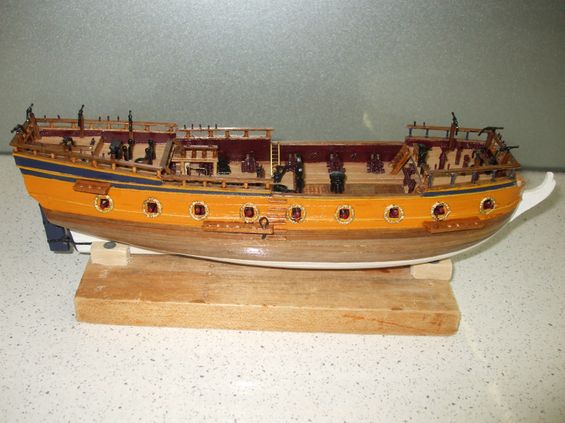Classic Ship Model 17
A PROFILE
HMS Peregrine 1704
HMS “Peregrine was one of a line of earlier similar vessels known as “6th rate”, being
armed with 18-20 small calibre cannons, designed and built for the fleet of King George 1. Being too light to participate in the major major battles alongside the the ‘ships of the line’, they were mainly used for transportation of important travellers,
escorting cargo ships, and for exploration. King George 11 chose one of these in his reign to be modified as his royal yacht, the “Carolina”. It was replaced in 1750 by a new royal yacht commissioned by the King and named the "Royal Caroline".
The "Peregrine then reverted to the navy.
Research on the ”Peregrine” itself is sparse but in investigating the time of her loss, we found that her Master, at the time of her foundering in bad weather, was Edward Knowles. Further research
indicated that when the “Peregrine” had actually been the “Carolina”, she had a poop deck constructed during the modification, which made it difficult to wear ship.
According to an article in 1766 by John Clevely the Elder,
“Apparently with the imminent declaration of war with Spain , it was necessary to send despatches to the British commands at Belle Island and Lisbon and Knowles was entrusted with the task. He rendezvoused with the fleet under Commodore Augustus Keppel
and passed on the news. Against the wishes of the Admiral, Knowles put to sea again in adverse conditions and was never seen again.” It was assumed the ship was lost on or sometime after December 28th 1761.
Footnote:
Edward Knowles......... Family and earlier life........He was born in 1744 being the only son of the then Captain Charles Knowles and Mary Alleyne. His father became a notable naval officer who
rose to the rank of Admiral, receiving a Baronetcy for services to his country. Edward attended Eton College , joined the navy and first served with Captain Richard Howe on HMS “Magnanime”. He later joined Admiral Sir Charles Saunders aboard the
HMS “Neptune”at the Siege of Louisbourg in February 1759. He was promoted to Lieutenant and transferred to the 100 gun HMS “Royal William to serve his commission. Whilst in command of the “Peregrine” , the Admiralty
made him a Post Captain, but the news never reached him.
HMS Peregrine Under Construction
Due to constant interruptions during its construction, this is the only intermediate photo I managed to take. It shows the completion of the hull structure and the inclusion of all the decking and fittings. The cannons proved to be difficult to secure in the sections underdeck. With them being placed there before the deck was closed, the protruding cannon barrels were exposed to accidental knocks which dislodged them. Getting them back in place with quick drying glue on their base - by pulling them through with a cotton line fed in from outside and tied to to barrel required a lot of patience. This happened on no less than six times as the construction progressed.
The Model
This model of HMS “Peregrine” is produced by Corel of Italy on a 1:96 scale. She has a length of 432 mms, a beam of 156 mms and Overall height of 320mms.
Having spent 15 months on my previous model, I chose a fairly complex but smaller
model in the hope that it would be easier on my eyesight and slightly unsteady fingers. I was wrong! I should have known, after almost 20 years experience, that the smaller the model the harder it is on the concentration requirements and delicate
finger work to reeve blocks and tie knots!
As it was, I commenced the construction on 1st July 2015 and completed it on the 28th August 2016 - 14 months in all. However, during that period we had many interruptions which prevented me from
spending time on my hobby. In fact I did very little from October 2015 until March 2016 - part of which time was taken in selling our house, buying and moving into another and setting up a new workshop. Roughly then it took around 10 months at
an average no longer than one hour per day which equates to a little under 300 hours.
Surprisingly, some of the timbers were rough cut and needed attention, many of the lead made fittings were easy to break and had to be fashioned from timber or
modified from spares. The cottons supplied were insufficient and some timbers required were not included The instructions were fair and required a lot of cross referencing with the parts list all being in Italian - which didn’t help. I have made
better models!
Needless to say, the completed vessel is quite pleasing to the eye with the gilding and paint style attractive. The rigging proved to be straightforward and generally it was done in an order which allowed for the lines to be kept taught with only a little adjustment here and there. As has been my custom, no sails were added although the canvas was supplied.
Updated 5.7.2017



